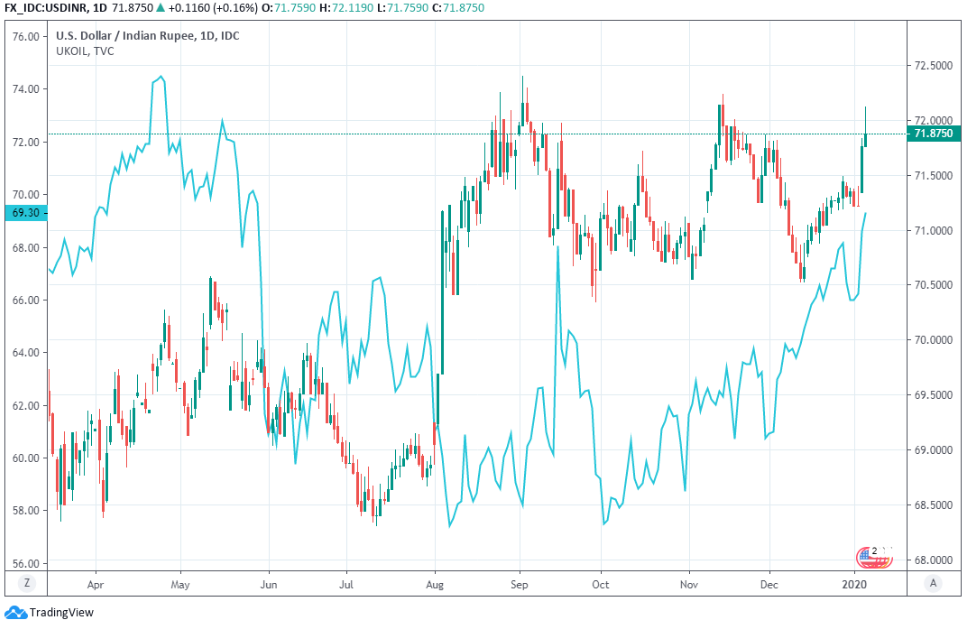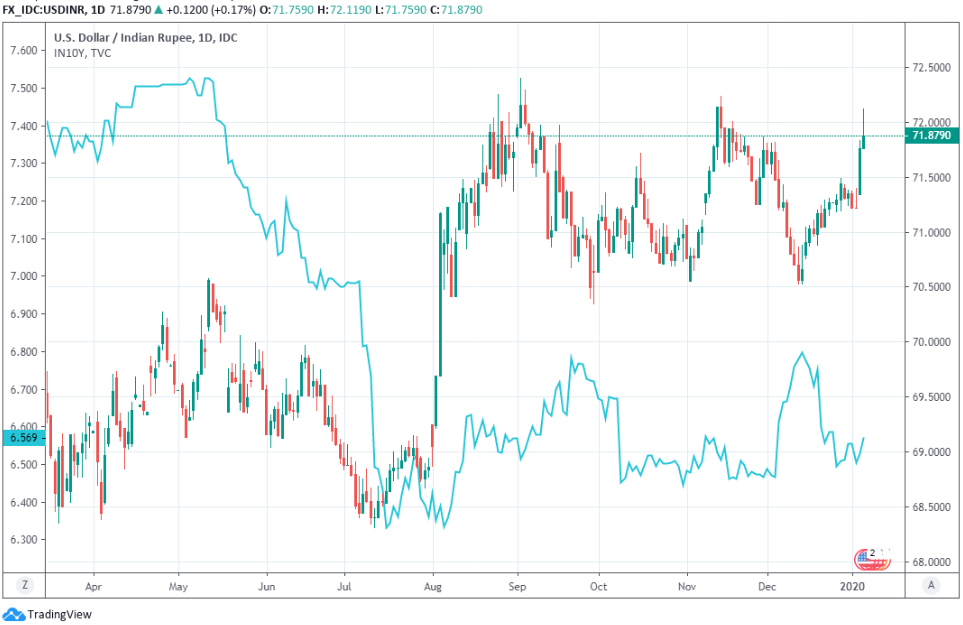Rupee's Headwinds are Mounting as Oil Rises and RBI Sits on Bond Yields
- Written by: James Skinner

Images © G20, Accessed Flickr, Creative Commons Licensing
- INR softens in January amid rising oil prices, risk aversion.
- After U.S.-Iran tensions flare, stoking fears of Gulf conflict.
- Iran fears to outweigh U.S.-China deal for INR, some say.
- As RBI squashes long-term bond yields, leans on the INR.
- Through Fed style 'operation twist' in Indian bond market.
- BMO says USD/INR to see "solid support" around 71.25.
The Rupee may already have seen its best levels for the foreseeable future, according to some to some forecasts, because headwinds are mounting and risks to the Indian currency abounding thus far in the New Year.
India's Rupee was in retreat from the Dollar and Pound Monday as Asian currencies underperformed their emerging market rivals, which were generally higher against the greenback and other major units. The Rupee, Philipine Peso, Korean Won and Chinese Renminbi were all lower against the Dollar while the Rand, Mexican Peso, Brazilian Real, Russian Rouble and a range of other currencies were winning back ground previously lost to the Dollar.
Monday's performance disparity between emerging market currencies has its roots in the ongoing flare up of tensions between the U.S. and Iran, which has lifted prices of Brent crude oil futures by 4.97% thus far in 2020 due to fears that a possible conflict will at least hinder the passage of much need barrels of oil through the Strait of Hormuz, a busy waterway in the Gulf through which around a third of the world's seaborne oil trade must pass.
"The Japanese yen should once again outperform - especially against those risk-sensitive currencies directly exposed to oil exports via the Straits of Hormuz, i.e. the Korean won and the Indian rupee," says Chris Turner, global head of strategy at ING.

Above: USD/INR rate shown at daily intervals alongside Brent crude oil futures price (blue line, left axis).
Iran has repeatedly threatened to use naval muscle in order to close the Strait of Hormuz, which would prevent oil tankers from transporting barrels loaded in the Persian Gulf to their destinations elsewhere in the world. And there is only limited pipeline capacity through which any such barrels could be transported to their end users, notably oil importing countries over in Asia.
There's uncertainty about how Iran will respond to the U.S. killing of General Qassam Soleimani in a missile strike last week, although ING says the country's options are limited to disrupting commercial traffic transiting the Strait, attacking oil tankers of U.S. allied countries and attacking oil infrastructure like pipelines. However, any such action might only serve to lift oil prices even further which would bad news for the Rupee because prices are already at their highest levels since May 2019.
"Higher oil prices and a weaker INR will increase the import bill which will in turn have a negative impact on both the fiscal and current account deficits. All in all, a sustained rise in oil prices leaves INR and the rest of Asia vulnerable to a further sell-off. This is likely to override the positive news from the US-China trade deal for now," says Charlie Lay, an analyst at Commerzbank.

Above: Pound-to-Rupee rate shown at daily intervals.
China's Vice Premier Lui He is reported by The South China Morning Post to be preparing to lead a delegation to Washington next week where he'll sign the 'phase one deal' that's expected to at least temporarily end the trade war between the world's two largest economies. Trump has himself said the pact will be signed on January 15.
That's a significant development for the global economy, which was badly wounded by the tariff fight over the course of 2018 and 2019.
'Risk assets' like stocks celebrated claims the agreement was being finalised throughout December but tensions between the U.S. and Iran are now expected to prevent the Rupee from sharing in the excitement.
Meanwhile, India's economy and central bank are also expected to be headwinds for the currency.
"Auction details suggest the central bank is keeping its simultaneous purchases & sales of long- & short-dated debt more evenly balanced relative to the first two auctions, which saw slightly larger sales of shorter-dated bonds," says Stephen Gallo, European head of FX strategy at BMO Capital Markets. "Intervention data point to a preference for controlled INR depreciation; we look to the 71.25/50 area for solid, medium-term support in USDINR."

Above: USD/INR rate shown at daily intervals alongside 10-year Indian government bond yield (blue line, left axis).
Oil woes are emerging at the same time as the Reserve Bank of India (RBI) uses its financial muscle to squash some government bond yields in the hope of enhancing the transmission of its interest rate cuts into the real economy. The RBI cut rates five times last year in an effort to stoke domestic demand and cushion the economy from a slowdown in global growth, but commercial banks appear to have passed less than half the cuts on to customers.
The RBI left its cash rate unchanged at 5.15% in December but noted the marginal-cost-of-funds-based lending rate had fallen only 49 basis points in 2019 when the bank had cut its own benchmark by a total of 135 basis points. The weighted-average-lending rate fell just 44 basis points and rates charged on some outstanding Rupee loans actually rose. The RBI is now intervening in the bond market to enhance the effect of its earlier decisions to cut borrowing costs.
Indian policymakers are now carrying out their own version of the 'operation twist' policy that's sometimes used by the Federal Reserve and involves the bank buying long-term government bonds in order to force down their yields, but offsetting the impact of those transactions on its balance sheet by simultaneously selling short-term bonds. The effect has been to cultivate a modest decline in the Indian government 10-year bond yield and expectations in the market of further declines to come.
Those yields represent the primary return earned by large internationla investors who buy the Rupee and given that they're in decline, the Indian currency could now become less attractive to prospective buyers and suffer as a result. The USD/INR rate often demonstrates a negative relationship with 10-year bond yields - although its correlation with oil is stronger - so the RBI's operation twist could be yet another headwind for the Indian currency to contend with in the weeks and months ahead.
Time to move your money? The Global Reach Best Exchange Rate Guarantee offers you competitive rates and maximises your currency transfer. Global Reach can offer great rates, tailored transfers, and market insight to help you choose the best times for you to trade. Speaking to a currency specialist helps you to capitalise on positive market shifts and make the most of your money. Find out more here.
* Advertisement

